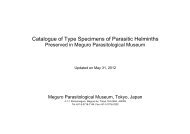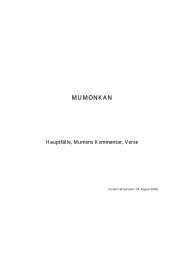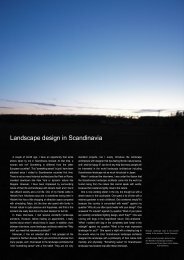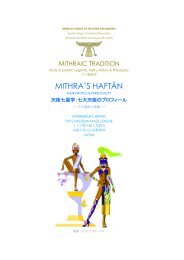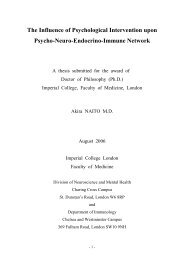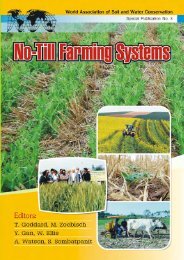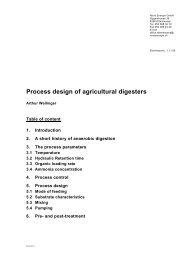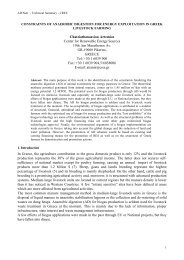Fusion of Australian Contemporary Dance and Mobius Kiryuho - nifty
Fusion of Australian Contemporary Dance and Mobius Kiryuho - nifty
Fusion of Australian Contemporary Dance and Mobius Kiryuho - nifty
Create successful ePaper yourself
Turn your PDF publications into a flip-book with our unique Google optimized e-Paper software.
Introduction<br />
<strong>Fusion</strong> <strong>of</strong> <strong>Australian</strong> <strong>Contemporary</strong> <strong>Dance</strong><br />
<strong>and</strong> <strong>Mobius</strong> <strong>Kiryuho</strong><br />
Elizabeth Cameron Dalman<br />
University <strong>of</strong> Western Sydney<br />
In recent years, <strong>Australian</strong> dancers <strong>and</strong> choreographers have been influenced<br />
by various movement <strong>and</strong> martial art practices from the Asia-Pacific region.<br />
Long interested in Buddhism <strong>and</strong> other Eastern philosophies, I too have been<br />
drawn to investigate such practices. <strong>Mobius</strong> <strong>Kiryuho</strong>, the Japanese Art <strong>of</strong><br />
Flowing Movement, founded by Master Kajo Tsuboi, has inspired me the<br />
most. What fascinates me about <strong>Mobius</strong> <strong>Kiryuho</strong> is the philosophy behind it,<br />
<strong>and</strong> Master Kajo’s continual references to nature, universal laws <strong>and</strong> the<br />
principles or ‘grammar‘ 1 <strong>of</strong> movement. Although there are many cultural <strong>and</strong><br />
dance practice differences between Japan <strong>and</strong> Australia, I have found that the<br />
<strong>Mobius</strong> <strong>Kiryuho</strong> philosophy <strong>and</strong> practice resonates in many ways in an<br />
<strong>Australian</strong> context.<br />
My first experience <strong>of</strong> <strong>Mobius</strong> <strong>Kiryuho</strong> was in the mid 1990s when a <strong>Mobius</strong><br />
<strong>Kiryuho</strong> practitioner, Teruomi Kuchina, came to Mirramu Creative Arts Centre<br />
in regional New South Wales, to lead a four-day ‘intensive’ in the practice. In<br />
1999, I went to Japan for a two-month intensive training course with Master<br />
Kajo, where I immersed myself in the practice <strong>and</strong> experienced the cultural<br />
significance <strong>and</strong> symbolism <strong>of</strong> many <strong>of</strong> its principles. Through my connection<br />
to the <strong>Mobius</strong> <strong>Kiryuho</strong> Institute I met Kyoko Sato, a performer, trained<br />
practitioner <strong>and</strong> teacher with Master Kajo.<br />
When Vivienne Rogis <strong>and</strong> I founded Mirramu <strong>Dance</strong> Company in 2000, we<br />
decided to complement <strong>and</strong> enrich the company’s <strong>Australian</strong> contemporary<br />
dance training by including the practice <strong>of</strong> <strong>Mobius</strong> <strong>Kiryuho</strong>. In discussing the
fusion <strong>of</strong> <strong>Australian</strong> contemporary dance <strong>and</strong> <strong>Mobius</strong> <strong>Kiryuho</strong> I refer in<br />
particular to the work <strong>of</strong> this contemporary dance company, which is<br />
significant in the dance theatre community <strong>of</strong> the <strong>Australian</strong> Capital Territory.<br />
Mirramu <strong>Dance</strong> Company develops its cross-cultural <strong>and</strong> interdisciplinary<br />
projects at Mirramu Creative Arts Centre, which is situated on the shores <strong>of</strong><br />
Weereewa/Lake George, where the expansive open l<strong>and</strong>scape inspires <strong>and</strong><br />
influences the dancers’ movement <strong>and</strong> choreographic practices.<br />
The training practiced by the performers <strong>of</strong> Mirramu <strong>Dance</strong> Company is based<br />
on <strong>and</strong> developed out <strong>of</strong> the philosophies <strong>and</strong> movement styles <strong>of</strong> some <strong>of</strong> the<br />
early American modern dance pioneers such as Martha Graham, Doris<br />
Humphrey, Jose Limon <strong>and</strong> Lester Horton. Added to these techniques are<br />
influences from various traditional <strong>and</strong> contemporary movement sources.<br />
A training method with a distinctive <strong>Australian</strong> aesthetic has evolved. This<br />
<strong>Australian</strong> aesthetic has grown out <strong>of</strong> a conscious acknowledgement <strong>of</strong> the<br />
power <strong>of</strong> the <strong>Australian</strong> l<strong>and</strong> <strong>and</strong> our <strong>Australian</strong> way <strong>of</strong> life, to make an imprint<br />
on our minds <strong>and</strong> bodies, <strong>and</strong> therefore on the way we move <strong>and</strong> express<br />
ourselves. Included in the dancers’ training, are studies <strong>of</strong> Indigenous<br />
<strong>Australian</strong> dance, taught to us by elders from the Pitjantjatjara region in the<br />
central desert, <strong>and</strong> Albert David from the Torres Strait Isl<strong>and</strong>s. These studies<br />
have taught us about Indigenous <strong>Australian</strong> ritual, the great mythic Dreaming<br />
stories that are connected to Country, <strong>and</strong> as well, they have introduced us to<br />
ancient <strong>Australian</strong> dance vocabularies.<br />
By applying the philosophies behind the various above-mentioned Western<br />
contemporary dance techniques to an <strong>Australian</strong> context, <strong>and</strong> through our<br />
studies <strong>of</strong> the Indigenous <strong>Australian</strong> dances, coupled with our own<br />
relationship <strong>and</strong> movement responses to the <strong>Australian</strong> l<strong>and</strong> <strong>and</strong> way <strong>of</strong> life, I<br />
believe that we have been able to find a unique <strong>Australian</strong> contemporary<br />
dance style. For the purposes <strong>of</strong> this paper, I therefore define our training as<br />
<strong>Australian</strong> contemporary dance.<br />
In 2002 Vivienne Rogis <strong>and</strong> I invited Kyoko Sato to participate in <strong>and</strong> be a<br />
guest teacher for our SILK project. SILK, created <strong>and</strong> premiered in 2002, with<br />
further performances in 2004 <strong>and</strong> 2005, presented both in Canberra <strong>and</strong><br />
Adelaide, is an example <strong>of</strong> how Mirramu <strong>Dance</strong> Company integrated<br />
<strong>Australian</strong> contemporary dance <strong>and</strong> <strong>Mobius</strong> <strong>Kiryuho</strong>. Through the <strong>Australian</strong><br />
Indigenous l<strong>and</strong> connection, that has given us important links to the naturecentred<br />
Shinto influences in the <strong>Mobius</strong> <strong>Kiryuho</strong> practice, conscious<br />
awareness in different approaches to core movement principles, <strong>and</strong> subtle<br />
changes in thought processes <strong>and</strong> performance modes, Mirramu <strong>Dance</strong><br />
Company has developed a new <strong>and</strong> significant style.<br />
Through my studies <strong>of</strong> <strong>Mobius</strong> <strong>Kiryuho</strong>, with its subtle way <strong>of</strong> working on the<br />
body, <strong>and</strong> its tapping <strong>of</strong> invisible energies <strong>and</strong> forces within the body <strong>and</strong> the<br />
mind, I found a way to explore the idea <strong>of</strong> silk in movement. I was also<br />
interested in investigating the divide, or the bridge, between Eastern <strong>and</strong><br />
Western modes <strong>of</strong> thought <strong>and</strong> behaviour. Just as the silk trade, through the<br />
famous Silk Road, had been instrumental in bringing East <strong>and</strong> West closer<br />
© 2009 E. Cameron Dalman 2<br />
<strong>Dance</strong> Dialogues: Conversations cross cultures, artforms <strong>and</strong> practices
together centuries ago, I believed that a fusion between <strong>Australian</strong><br />
contemporary dance (with its Western contemporary dance influences) <strong>and</strong><br />
<strong>Mobius</strong> <strong>Kiryuho</strong> (a contemporary Eastern movement art steeped in the<br />
ancient practice <strong>of</strong> Aikido) could produce a contemporary ‘Silk Road’ through<br />
dance.<br />
The silk story itself – the basic <strong>and</strong> simple beginnings <strong>of</strong> the silkworm, through<br />
the cocoon stage, to the spinning <strong>of</strong> the silk <strong>and</strong> finally to its sophisticated <strong>and</strong><br />
complex outcome in fashion houses around the world – became an allegory<br />
for the choreography.<br />
Kyoko Sato as the Worm <strong>and</strong> Vivienne Rogis as a Model in SILK Photo: Robert Guth<br />
The juxta-positioning <strong>of</strong> simplicity with sophisticated complexity, as in the silk<br />
story, became a key for the creative process. Simple movements were<br />
developed into complex movement patterns, layered choreographed sections<br />
were included with dances that were improvised, <strong>and</strong> movement variations<br />
were danced in partnership with the silk material itself. The principles <strong>of</strong><br />
breath, gravity <strong>and</strong> the flow <strong>of</strong> energy through the body were consciously<br />
crafted into a multifaceted cross-cultural choreographic work – a ‘Silk Road’ in<br />
dance.<br />
I will now discuss these three movement principles, core principles to both<br />
practices, highlighting similarities <strong>and</strong> differences <strong>of</strong> approach within the two<br />
practices, <strong>and</strong> give examples <strong>of</strong> how, through our choreographic development<br />
<strong>and</strong> presentations <strong>of</strong> SILK, we found a fusion <strong>of</strong> the two practices.<br />
Breath<br />
The principle <strong>of</strong> the awareness <strong>of</strong> breath was paramount to, <strong>and</strong> addressed<br />
very particularly by many <strong>of</strong> the early Western contemporary/modern dance<br />
pioneers.<br />
© 2009 E. Cameron Dalman 3<br />
<strong>Dance</strong> Dialogues: Conversations cross cultures, artforms <strong>and</strong> practices
Isadora Duncan (1977, p. 55) in her search for a more ‘natural’ way <strong>of</strong><br />
dancing devised sequences <strong>of</strong> movement with very precise breathing<br />
patterns. The movement shapes <strong>and</strong> forms coupled with a sense <strong>of</strong><br />
ab<strong>and</strong>onment <strong>and</strong> freedom were based on dancing poses she found on the<br />
friezes, buildings <strong>and</strong> art works <strong>of</strong> ancient Greece, while the breathing<br />
patterns were based on her practice <strong>of</strong> Hatha Yoga.<br />
‘For Martha Graham, it all began with the act <strong>of</strong> breath – the start <strong>of</strong> life itself’<br />
(Cohen, 1966, p. 8). Graham watched the natural flow <strong>of</strong> the breath through<br />
the body <strong>and</strong> then intensified the dramatics <strong>of</strong> that action. She gradually<br />
developed her technique <strong>of</strong> ‘contraction <strong>and</strong> release’ from this research,<br />
linking these actions <strong>of</strong> the breath to her psychological interest in dance <strong>and</strong><br />
drama.<br />
Doris Humphrey (1959) believed that following every action there is a<br />
reaction. This led her to create many exercises involving the awareness <strong>of</strong> the<br />
passage <strong>of</strong> breath through the body. She also developed specific sequential<br />
movement phrases initiated by changes in breathing patterns. Her technique<br />
<strong>of</strong> ‘fall <strong>and</strong> recovery’ was linked not only to the power <strong>of</strong> the pull <strong>of</strong> gravity but<br />
also to the rising <strong>and</strong> the falling <strong>of</strong> the breath. The excitement in movement<br />
she found to be in the extension <strong>of</strong> the spaces between the inhalation <strong>and</strong> the<br />
exhalation – the suspension. By controlling the breath patterns she could<br />
extend her movement dynamics, qualities <strong>and</strong> vocabulary, giving special<br />
attention to this surprise element <strong>of</strong> suspension.<br />
Margaret Morris, a modern dance pioneer in Engl<strong>and</strong>, had incorporated some<br />
<strong>of</strong> Isadora Duncan’s exercises into her own methodology <strong>of</strong> dance training.<br />
My experience <strong>of</strong> studying the Margaret Morris technique with Nora Stewart<br />
when I was a child gave me an introduction to the conscious awareness <strong>of</strong> the<br />
movement <strong>of</strong> the breath <strong>and</strong> the importance <strong>of</strong> incorporating it with dance.<br />
The Graham <strong>and</strong> Humphrey techniques <strong>and</strong> philosophies were the basis <strong>of</strong><br />
my later training in contemporary dance, <strong>and</strong> I therefore refer <strong>of</strong>ten to their<br />
theories <strong>and</strong> exercises, noting both the internal focus on the breath moving<br />
through the body, <strong>and</strong> the importance <strong>of</strong> the breath in the external relationship<br />
<strong>of</strong> the dancer to the space, particularly in the moments <strong>of</strong> suspension.<br />
This internal concentration <strong>of</strong> movement inside the body is indeed similar to<br />
the practice <strong>of</strong> <strong>Mobius</strong> <strong>Kiryuho</strong>. However in <strong>Mobius</strong> <strong>Kiryuho</strong>, conscious control<br />
<strong>of</strong> the breath is not encouraged. The practice is more concerned with<br />
changing the frame <strong>of</strong> mind <strong>and</strong> with the opening <strong>of</strong> the awareness to the<br />
breathing function <strong>of</strong> the body. The practitioner is advised to merely observe<br />
the changes in the breath as the body moves with a variety <strong>of</strong> different<br />
dynamics.<br />
During the SILK project, we played with both theories, deepening our<br />
conscious awareness in the moments <strong>of</strong> controlled breathing <strong>and</strong> in the<br />
moments <strong>of</strong> more meditative movement patterns. In choreographing the Moth<br />
solo in SILK I leaned more towards the <strong>Mobius</strong> <strong>Kiryuho</strong> theory, watching<br />
© 2009 E. Cameron Dalman 4<br />
<strong>Dance</strong> Dialogues: Conversations cross cultures, artforms <strong>and</strong> practices
intensely the movement <strong>of</strong> the breath through my body. I was also acutely<br />
aware <strong>of</strong> the changes <strong>of</strong> the air outside my body as it moved the huge silk<br />
wings that I carried. It was a challenge to NOT choreograph. Instead I had to<br />
initiate a movement for the silk <strong>and</strong> then let it indicate the next movement. In<br />
order to keep the wings still moving, I had to ‘let the dance, dance the dancer’<br />
as Master Kajo reminded us. 2<br />
Elizabeth Cameron Dalman as the Moth in SILK Photo: Robert Guth<br />
After much coaching from Kyoko during the rehearsals <strong>of</strong> SILK, <strong>and</strong> several<br />
performances <strong>of</strong> the Moth solo, I understood what Master Kajo was teaching<br />
in respect <strong>of</strong> the ‘dance dancing the dancer’. The material <strong>of</strong> silk has its own<br />
life. It breathes <strong>and</strong> moves in its own way. Like another body, it became my<br />
teacher. My challenge was to learn to listen to the silk as I danced, to feel its<br />
every movement, no matter how slight, <strong>and</strong> to respond accordingly to both the<br />
material <strong>and</strong> to the movement <strong>of</strong> the air between us. This air between, <strong>and</strong><br />
around us, was constantly changing through our subtle or sometimes dynamic<br />
conversations.<br />
Ma – as suspension<br />
Ma is a classic word that is associated with Japanese philosophy <strong>and</strong> spiritual<br />
practices, <strong>and</strong> also referred to in Indo-European literature. Although the<br />
Japanese concept <strong>of</strong> ma is more abstract, there are some parallel meanings<br />
to the Indo-European ones especially in the sense <strong>of</strong> ‘fluidity’, ‘birth’,<br />
‘beginning’ <strong>and</strong> ‘connection’.<br />
Master Kajo speaks <strong>of</strong>ten <strong>of</strong> ma as a space <strong>of</strong> ‘pregnant emptiness’, or as a<br />
golden ball <strong>of</strong> energy similar to the depiction <strong>of</strong> the Chinese characters, which<br />
Stock (2005, p. 30), (informed by a discussion with Maria Adriana<br />
Verdaasdonk), in describing ma refers to ‘a gate or door (mon) with the<br />
© 2009 E. Cameron Dalman 5<br />
<strong>Dance</strong> Dialogues: Conversations cross cultures, artforms <strong>and</strong> practices
character for sun (hi) or moon (tsuki) passing through.’ My underst<strong>and</strong>ing <strong>of</strong><br />
the Japanese meaning <strong>of</strong> ma came in the dancing <strong>of</strong> the Moth solo. I<br />
experienced it like the suspension between an inhalation <strong>and</strong> an exhalation <strong>of</strong><br />
the breath – a state <strong>of</strong> no movement. However, in that moment <strong>of</strong> no<br />
movement I experienced a great deal <strong>of</strong> suspended energy. There was a<br />
living, breathing connection <strong>and</strong> a strong relationship between my body <strong>and</strong><br />
the space around it, thus intensified in the stillness, or the ma concept <strong>of</strong><br />
space/time.<br />
The <strong>Mobius</strong> <strong>Kiryuho</strong> practice <strong>of</strong> the figure eight walking in pairs helped the<br />
dancers <strong>of</strong> Mirramu <strong>Dance</strong> Company to embody the space/time quality <strong>of</strong> ma.<br />
We are facing our partner directly, both with knees relaxed <strong>and</strong> bent; arms<br />
relaxed, but curved in a circle in front <strong>of</strong> our navels; chest relaxed; eyes<br />
connecting to our partner’s eyes. There is a second <strong>of</strong> emptiness, or ma, <strong>and</strong><br />
then as if walking through the centre <strong>of</strong> our partner, we begin an inhalation. To<br />
avoid touching our partner, the shoulders <strong>and</strong> upper body turn slightly at the<br />
point <strong>of</strong> passing. We then carry on walking the second half <strong>of</strong> the figure eight<br />
finishing that inhalation. From the peak <strong>of</strong> the outer circle we begin another<br />
exhalation, which brings us back to face our partner again at the point <strong>of</strong> ma –<br />
relaxed, empty, but with energy.<br />
As a part <strong>of</strong> the SILK production we included a scene called MA. In creating a<br />
state <strong>of</strong> ‘emptiness’ or no movement I decided to build movement phrases<br />
interrupted by moments <strong>of</strong> stillness. I was reminded <strong>of</strong> José Limon’s solo for<br />
Silence in There is a Time, <strong>and</strong> realised the importance <strong>of</strong> opposites. Before<br />
the Silence soloist entered, Jose had a male dancer perform a dynamic <strong>and</strong><br />
energetic solo, while other dancers played complex stick rhythms at the side<br />
<strong>of</strong> the stage. The sound suddenly stops. The audience is then aware <strong>of</strong> the<br />
silence <strong>and</strong> the floating solo female figure circling the space. She pauses,<br />
holding the silence, as the last echoes <strong>of</strong> the rhythm disappear. She continues<br />
her dance – in silence.<br />
I believed that to show NO movement through movement, we needed<br />
movement contrasted with stillness. We therefore explored stillness with<br />
aliveness – a kind <strong>of</strong> suspended energy waiting to be let out. We questioned<br />
how long to hold this stillness in order to create the sensation <strong>of</strong> ma. Our next<br />
challenge was whether to let out that energy suddenly or with control. Let out<br />
suddenly, although breaking the dream-like meditative state, it was effective in<br />
some instances. Controlled, it came out in a slow steady stream like a hum. In<br />
the latter case we explored the Japanese way <strong>of</strong> walking flat-footed, with<br />
knees bent <strong>and</strong> s<strong>of</strong>t, <strong>and</strong> moved continuously in an uninterrupted line, as if we<br />
were skimming the surface <strong>of</strong> the stage. When coming to a stop we found a<br />
position <strong>and</strong> held that position, not with tension but with energy. We held the<br />
position, not for the sake <strong>of</strong> the shape we were creating, or because it was the<br />
end <strong>of</strong> a phrase, but rather for the sense <strong>of</strong> holding energy. Although this was<br />
similar to an exercise we practice in improvisational sessions where we allow<br />
the space around us to move the body <strong>and</strong> do the shape-changing, the<br />
creative development <strong>of</strong> MA was a new choreographic challenge in the<br />
process <strong>of</strong> the fusion we were attempting.<br />
© 2009 E. Cameron Dalman 6<br />
<strong>Dance</strong> Dialogues: Conversations cross cultures, artforms <strong>and</strong> practices
Gravity<br />
In The Art <strong>of</strong> Making <strong>Dance</strong>s Doris Humphrey (1959, p. 106) states that ‘All<br />
life fluctuates between resistance to <strong>and</strong> yielding to gravity’ <strong>and</strong> with this in the<br />
forefront <strong>of</strong> her mind she created her theory <strong>and</strong> practice <strong>of</strong> fall <strong>and</strong> recovery.<br />
As part <strong>of</strong> their breaking away from the classical ballet form, where dancers<br />
constantly resisted the force <strong>of</strong> gravity to create illusions <strong>of</strong> flight, <strong>of</strong> leaving<br />
the earth both physically <strong>and</strong> metaphorically, the modern dance pioneers<br />
made analytical <strong>and</strong> theoretical inroads into researching how gravity reacts on<br />
the body. They experimented with movements in <strong>and</strong> out <strong>of</strong> the floor, working<br />
with or against the force <strong>of</strong> gravity, both in a conscious <strong>and</strong> a creative way.<br />
This research into how gravity impacts on the dancing body continues today.<br />
In current contemporary dance trends dancers use the force <strong>of</strong> gravity as a<br />
source <strong>of</strong> energy. The pull <strong>of</strong> gravity into the ground, for example, gives<br />
energy to rebound out <strong>of</strong> the ground, a fall in <strong>of</strong>f-balance moments, gives<br />
surprise in dance <strong>and</strong> can generate new movements, such as a twist, a turn, a<br />
leap or another fall, thus helping to build a greater movement vocabulary.<br />
In the <strong>Mobius</strong> <strong>Kiryuho</strong> practice there is a much more subtle approach to the<br />
underst<strong>and</strong>ing <strong>of</strong> gravity. From his research <strong>and</strong> experience <strong>of</strong> the ancient<br />
Japanese sword practice, where there is great attention given to the vertical<br />
line, <strong>and</strong> <strong>of</strong> the body’s relationship to this line, Master Kajo created a series <strong>of</strong><br />
exercises, many <strong>of</strong> which are similar to full plies. With concentration focussed<br />
internally on the spinal column as a pure vertical line, the plie begins with a<br />
relaxed body <strong>and</strong> a s<strong>of</strong>t surrendering to the ground.<br />
In contrast, I am reminded <strong>of</strong> José Limon’s theory <strong>of</strong> energy radiating out from<br />
the centre <strong>of</strong> the body through the five external points <strong>of</strong> the body – the crown<br />
<strong>of</strong> the head to the universe, outstretched arms to the space outside <strong>and</strong><br />
widely spaced legs to the ground below. In order to sense the vertical line the<br />
dancer must imagine <strong>and</strong> feel, while executing his series <strong>of</strong> plies for example,<br />
the oppositional pull <strong>of</strong> the earth <strong>and</strong> the sky. This is a very different concept<br />
to the more subtle approach found in <strong>Mobius</strong> <strong>Kiryuho</strong>.<br />
There are several exercises in <strong>Mobius</strong> <strong>Kiryuho</strong> where we are asked to feel the<br />
force <strong>of</strong> gravity acting upon us. Having raised the arms high above the head<br />
we are then asked to feel the force <strong>of</strong> gravity lowering them. We then<br />
surrender the whole body to this force, in a spiralling action <strong>of</strong> the <strong>Mobius</strong> loop<br />
movement through the spinal column. With a relaxed body, heavy like water,<br />
we descend to the ground. This must be done with consciousness, so that at<br />
a specific moment we can rise out <strong>of</strong> the squat position <strong>and</strong> reach up to the<br />
peak <strong>of</strong> the vertical line again, but with no oppositional pull. Another <strong>Mobius</strong><br />
<strong>Kiryuho</strong> exercise illustrating this subtle surrendering to the earth, involves us<br />
emulating the movement <strong>of</strong> a piece <strong>of</strong> rice paper as it floats from above, to the<br />
ground.<br />
Kazuo Ohno (1999), the Father <strong>of</strong> Butoh, speaks in a similar way:<br />
© 2009 E. Cameron Dalman 7<br />
<strong>Dance</strong> Dialogues: Conversations cross cultures, artforms <strong>and</strong> practices
We come to class to fine-tune the body, to get in touch with the inner body.<br />
Imagine a fine sheet <strong>of</strong> h<strong>and</strong> made paper, almost transparent, fluttering in the<br />
air. The body needs to be like this. 3<br />
After our training in Western contemporary dance-based work, we were<br />
challenged now by Eastern theories <strong>of</strong> relaxation <strong>and</strong> s<strong>of</strong>tness, by a constant<br />
inner focus on movement rather than an outer one. Working with such a<br />
relaxed body as in <strong>Mobius</strong> <strong>Kiryuho</strong>, we had to make several adjustments both<br />
physically <strong>and</strong> mentally. Our relationship to gravity <strong>and</strong> to the way we<br />
executed our movements was now different.<br />
Flow <strong>of</strong> energy through the body<br />
Buddhists aspire to the ‘subtle body’, constructed through meditation <strong>and</strong><br />
philosophy; a body which can reflect the essence <strong>of</strong> things <strong>and</strong> which is<br />
mapped by ch’i or energy flows.<br />
(Stock, (with reference to Solomon), 2005, p. 28)<br />
In his lectures on <strong>Mobius</strong> <strong>Kiryuho</strong> Master Kajo talks about the ‘subtle’ body.<br />
However his term for it is the ‘invisible body’ <strong>and</strong> perhaps differs slightly in<br />
meaning from the one to which Stock <strong>and</strong> Solomon refer in the above<br />
quotation. While always referring to the essence <strong>of</strong> things <strong>and</strong> the mapping <strong>of</strong><br />
the energy flows through the body, Master Kajo gives many exercises that he<br />
has developed from Aikido, focussing on various points in the body (not<br />
pressure points, but what he terms ‘vulnerable’ points), where the body very<br />
easily surrenders to pressure. This is one <strong>of</strong> the ways that he demonstrates<br />
how the dance <strong>of</strong> the body has its own movement pathways <strong>and</strong> its own way<br />
over the mind/body control that we think we have. He is interested in this<br />
subtle body <strong>and</strong> trains his practitioners to be aware <strong>of</strong> the dance between the<br />
controlled <strong>and</strong> the ‘invisible/subtle’ body. In awakening the ‘subtle’ body he is<br />
always encouraging his students to let the dance, (the movement <strong>of</strong> the figure<br />
eight – yawaraghe, for example) dance them.<br />
In an exercise called the three R’s we learn to follow energy through the body.<br />
The first R is Relaxation. Always in <strong>Mobius</strong> <strong>Kiryuho</strong> we are asked to move like<br />
a water bag – heavily, with fluidity, <strong>and</strong> with relaxation, watching internally as<br />
movement travels from one relaxed part <strong>of</strong> the body to the next. The second<br />
R is Relationship. As the energy moves through the body, we are asked to<br />
notice the relationship between one body part <strong>and</strong> the next. For example, a<br />
movement from one body part can be the initiator for another movement<br />
<strong>and</strong>/or another body part. The third R is Realisation. In underst<strong>and</strong>ing<br />
Realisation we are awakened to a conscious underst<strong>and</strong>ing <strong>and</strong> an<br />
awareness <strong>of</strong> an integrated body, <strong>of</strong> the body/mind relationship <strong>and</strong> <strong>of</strong> the<br />
body moving through space, both from an internal <strong>and</strong> an external point <strong>of</strong><br />
view. In practising all three R‘s together, we must be moving in a relaxed way,<br />
conscious <strong>of</strong> the relationship <strong>of</strong> body part to body part <strong>and</strong> with realisation <strong>of</strong><br />
an integrated body moving in the world.<br />
Doris Humphrey (in Stodelle, 1978, p. 18) talked about the importance <strong>of</strong> the<br />
kinetics <strong>of</strong> dance. ‘Since dance is kinetic, not primarily literary, dramatic or<br />
musical... training should aim first at feeling for movement in design, in<br />
© 2009 E. Cameron Dalman 8<br />
<strong>Dance</strong> Dialogues: Conversations cross cultures, artforms <strong>and</strong> practices
hythm, in quality.’ This ‘feeling for movement’ was a key to the development<br />
<strong>of</strong> contemporary dance during the 20 th century. Even after the generation <strong>of</strong><br />
choreographers to which Humphrey belonged had passed on, <strong>and</strong> as new<br />
techniques <strong>and</strong> philosophies developed <strong>and</strong> many theories changed, the idea<br />
<strong>of</strong> ‘the feeling for movement’ never died; in fact it became more intensified.<br />
Rather than putting attention on watching the form <strong>of</strong> the dance from the<br />
outside, I have always encouraged dancers to work without mirrors, to ‘feel’<br />
movement from inside, <strong>and</strong> be aware <strong>of</strong> successional movement through the<br />
body. The Humphrey/Limon techniques, which we practice, emphasise<br />
successional movement through the body. For example, movement is initiated<br />
as a result <strong>of</strong> the breath travelling through the torso, or a rebound occurs after<br />
a falling movement, <strong>and</strong> so on. So in practising the three R’s exercise we<br />
could relate to this concentration on the internal observation <strong>of</strong> energy through<br />
the body. However the <strong>Mobius</strong> <strong>Kiryuho</strong> training helped us to deepen our<br />
visualisations <strong>and</strong> develop more subtle <strong>and</strong> sensual ways <strong>of</strong> moving.<br />
Choreographic challenges<br />
Although he emphasises the dance aspect <strong>of</strong> the <strong>Mobius</strong> <strong>Kiryuho</strong> practice,<br />
Master Kajo rarely directs dance productions <strong>and</strong> performances. He teaches<br />
the practice primarily as a martial art, moving meditation <strong>and</strong>/or a healing<br />
practice. The dance presentations <strong>of</strong> <strong>Mobius</strong> <strong>Kiryuho</strong> are improvisational,<br />
based on the organic flow <strong>of</strong> movement through the body <strong>and</strong> may follow a<br />
preconceived map or idea depending upon the occasion or event.<br />
Kent de Spain (2003, p. 27) defines improvisation as:<br />
... a way <strong>of</strong> being present in the moment, <strong>and</strong> your awareness <strong>of</strong> that<br />
moment challenges <strong>and</strong> refines your presence in each subsequent<br />
moment.<br />
De Spain’s definition is, I feel most relevant to the improvisational way <strong>of</strong><br />
moving encouraged in the practice <strong>of</strong> <strong>Mobius</strong> <strong>Kiryuho</strong>, where Master Kajo<br />
refers constantly to being conscious in every moment.<br />
In spite <strong>of</strong> the powerful performative appearance <strong>of</strong> <strong>Mobius</strong> <strong>Kiryuho</strong><br />
presentations, where the practitioners move as if they are performers, there is<br />
little or no attention given to choreographic shape or theatrical design. This in<br />
no way lessens its power <strong>and</strong> potential as dance. Kyoko Sato, who has given<br />
many solo performances in Europe <strong>and</strong> Japan, for example, is an improviser<br />
with a powerful presence on stage performing exquisite movements that<br />
evoke highly emotional responses.<br />
Apart from the form <strong>of</strong> the <strong>Mobius</strong> loop itself, which is drawn in the space by<br />
different parts <strong>of</strong> the body, <strong>Mobius</strong> <strong>Kiryuho</strong> is a formless technique. There are<br />
no fixed positions. There is only movement. <strong>Mobius</strong> <strong>Kiryuho</strong> uses<br />
improvisation as an end in itself mainly for practitioners to discover <strong>and</strong><br />
experience the ‘grammar’ <strong>of</strong> movement, rather than as a vehicle for creative<br />
expression.<br />
© 2009 E. Cameron Dalman 9<br />
<strong>Dance</strong> Dialogues: Conversations cross cultures, artforms <strong>and</strong> practices
Mirramu <strong>Dance</strong> Company on the other h<strong>and</strong> uses improvisation as a means<br />
to an end. As a resident choreographer, I incorporate various improvisation<br />
methodologies into the dancers’ training, <strong>and</strong> run improvisation sessions as a<br />
part <strong>of</strong> the creative development phase <strong>of</strong> a new choreography. I believe, like<br />
Victoria Marks (2003, p. 135), that beautiful dance phrases are found as<br />
dancers improvise together:<br />
...improvisation is the place for things to happen between people, or between<br />
the dancers <strong>and</strong> the dance. . . . The dance is found in between the people, in<br />
the moment, <strong>and</strong> <strong>of</strong>ten in places where I least expect to find it...<br />
From a choreographic point <strong>of</strong> view, I am mostly interested in shape <strong>and</strong> form.<br />
For me dance is like moving sculpture. I like to ‘sculpt’ the stage space with<br />
the dancers’ moving bodies, creating designs <strong>and</strong> patterns both for visual <strong>and</strong><br />
dramatic effect. I choreograph <strong>and</strong> craft many sections. However my<br />
fascination with improvisation prompts me to use movement motifs <strong>and</strong><br />
phrases that have been developed from remembered movement pathways<br />
discovered in the improvisation sessions. These ‘improvised’ movements are<br />
then developed into the body <strong>of</strong> the choreography. The fact that these<br />
movement shapes, designs <strong>and</strong> patterns have evolved not simply from an<br />
intellectual or external approach, but from the internal l<strong>and</strong>scape <strong>of</strong> the body,<br />
the feeling <strong>of</strong> the movement or the energy generated by a movement, emotion<br />
or idea, gives authenticity <strong>and</strong> strength to the work at h<strong>and</strong>. The training in<br />
<strong>Mobius</strong> <strong>Kiryuho</strong> therefore helps us to refine our improvisation skills, <strong>and</strong> so<br />
leads us into more experimentation <strong>of</strong> <strong>and</strong> exploration into a wider movement<br />
vocabulary.<br />
In the SILK project we challenged ourselves by combining both<br />
improvisational <strong>and</strong> structured choreographic processes. The Worm <strong>and</strong><br />
Models section is a good example illustrating the integration <strong>and</strong> fusion <strong>of</strong><br />
form with formlessness. As choreographer/conductor for the work I juxtapositioned<br />
a choreographed duet with an improvised solo. Kyoko Sato as the<br />
Worm was elevated <strong>and</strong> spot lit centre stage above the Models who moved in<br />
corridors <strong>of</strong> light on either side <strong>of</strong> the platform. Using the technique from the<br />
three R’s exercise <strong>of</strong> following the energy flow through her body Kyoko<br />
worked from the internal feeling <strong>of</strong> the movement improvising movements that<br />
simulated a silkworm – the eating <strong>of</strong> mulberry leaves or the spinning <strong>of</strong> the<br />
cocoon around her body. Sometimes I asked her to freeze a position for a<br />
while, both to counterpoint <strong>and</strong> compliment what the Models were doing.<br />
However having her internal concentration interrupted in this way, did not<br />
always feel right for Kyoko <strong>and</strong> having to pick up the movement again at a<br />
particular moment in time (the Western way <strong>of</strong> counting was also confusing<br />
for her) added to her specific challenges in the project.<br />
The Models were also working with the feeling <strong>of</strong> the movement, but from a<br />
choreographed, dynamic <strong>and</strong> controlled way. I looked for the drama that<br />
emerged from the movements the Models were doing <strong>and</strong> in order to build<br />
dramatic tensions between them <strong>and</strong> the Worm, I <strong>of</strong>ten asked them to<br />
highlight various moments by accenting, quickening or slowing movements<br />
down. Conscious <strong>of</strong> contrasting the different dance forms, I worked with the<br />
© 2009 E. Cameron Dalman 10<br />
<strong>Dance</strong> Dialogues: Conversations cross cultures, artforms <strong>and</strong> practices
feel <strong>of</strong> the movement on two levels in the bigger space <strong>of</strong> the stage, crafting<br />
the overall design, rhythm <strong>and</strong> dynamic <strong>of</strong> the choreography.<br />
There were variations in every performance mainly due to the improvisatory<br />
nature <strong>of</strong> Kyoko’s solo. However there was enough visual, dramatic <strong>and</strong><br />
movement contrast, to always produce the impact that I wanted in this scene.<br />
In the end it was the contrasting movement qualities, the layering <strong>of</strong><br />
movement techniques <strong>and</strong> dramatic tensions that counted in this scene <strong>and</strong> it<br />
was exciting to witness how choreographically these two dance disciplines<br />
could work together.<br />
Summary<br />
The fusion between <strong>Australian</strong> contemporary dance <strong>and</strong> <strong>Mobius</strong> <strong>Kiryuho</strong> that<br />
occurred during the choreographic processes for, <strong>and</strong> the performances <strong>of</strong><br />
SILK, highlighted <strong>and</strong> deepened our awareness <strong>of</strong> the principles <strong>of</strong><br />
movement. As well, we found a more flowing, lyrical quality to our work, <strong>and</strong> a<br />
greater expressiveness <strong>and</strong> precision to silences <strong>and</strong> pauses. For Kyoko it<br />
was an intensive choreographic <strong>and</strong> theatrical learning experience.<br />
SILK also involved a meeting <strong>of</strong> our differing cultures - the dancers <strong>of</strong> Mirramu<br />
<strong>Dance</strong> Company representing Australia’s eclectic mix <strong>of</strong> cultures, while Kyoko<br />
represented the Japanese culture with its long unbroken connection to ancient<br />
sources. By finding the universal links between us, in particular through the<br />
exploration <strong>of</strong> the core principles behind the two different cultural dance<br />
histories, a harmonious <strong>and</strong> layered fusion could be made.<br />
I believe the fusion worked because <strong>of</strong> the dancers’ <strong>Australian</strong> contemporary<br />
dance training, their prior underst<strong>and</strong>ing <strong>and</strong> experience <strong>of</strong> various<br />
improvisation methodologies, their interest <strong>and</strong> immersion in the <strong>Mobius</strong><br />
<strong>Kiryuho</strong> practice <strong>and</strong> their readiness to break new ground choreographically.<br />
Kyoko’s enthusiasm <strong>and</strong> openness to new challenges <strong>and</strong> her thirst for<br />
knowledge <strong>of</strong> Western contemporary dance/theatre choreographic practice<br />
<strong>and</strong> presentation, gave her enormous incentive to make the project work.<br />
An Assessors’ Report by the Australia Council in 2004 acknowledged the<br />
success <strong>of</strong> the fusion in the following statement:<br />
This relationship (between Mirramu <strong>Dance</strong> Company <strong>and</strong> the <strong>Mobius</strong> <strong>Kiryuho</strong><br />
Institute in Japan) has obviously influenced the style, content <strong>and</strong> processes<br />
<strong>of</strong> the Mirramu <strong>Dance</strong> Company <strong>and</strong> creates an interesting mix, providing<br />
challenges in how two different cultural dance histories can converge <strong>and</strong><br />
create new performance. . . With further cross cultural exploration <strong>and</strong> time,<br />
this company has the potential to break new ground in <strong>Australian</strong> dance. 4<br />
© 2009 E. Cameron Dalman 11<br />
<strong>Dance</strong> Dialogues: Conversations cross cultures, artforms <strong>and</strong> practices
Notes<br />
1<br />
<strong>Mobius</strong> Kiruyo, printed booklet, h<strong>and</strong>ed out in workshops given at Mirramu Creative<br />
Arts Centre, 2002.<br />
2<br />
Quotation from Master Kajo, personal journal notes <strong>of</strong> a course undertaken in<br />
Tokyo 1999.<br />
3<br />
Kazuo Ohno, personal notes taken in class in Japan, 1999.<br />
4<br />
Australia Council’s Assessment Report after having seen Silk <strong>and</strong> Sun, November,<br />
2004.<br />
References<br />
Cohen, S. J. (1966). The Modern <strong>Dance</strong>, Seven Statements <strong>of</strong> Belief.<br />
Middletown, Connecticut: Wesleyan Press.<br />
De Spain, K. (2003). The Cutting Edge <strong>of</strong> Awareness. In A Cooper Albright &<br />
D. Gere (Eds.), A <strong>Dance</strong> Improvisation Reader (pp. 27-38).<br />
Middletown, Connecticut: Wesleyan University Press.<br />
Duncan, I. (1977). The Art <strong>of</strong> the <strong>Dance</strong>. Theatre Arts Books: New York.<br />
Humphrey, D. (1959). The Art <strong>of</strong> Making <strong>Dance</strong>s. New York: Grove Press,<br />
Inc.<br />
Marks, V. (2003). Taken by Surprise. In A. Cooper Albright & D. Gere (Eds.),<br />
A <strong>Dance</strong> Improvisation Reader (pp. 135-139). Middletown, Connecticut:<br />
Wesleyan University Press.<br />
Stock, C. (2005). The interval between…. the space between…: Concepts <strong>of</strong><br />
Time <strong>and</strong> Space in Asian Performance. In U. Sarkar Munsi (Ed.), Time<br />
<strong>and</strong> Space in Asian context: <strong>Contemporary</strong> <strong>Dance</strong> in Asia (pp. 17-37).<br />
Kolkata, India: World <strong>Dance</strong> Alliance – West Bengal.<br />
Stodelle, E. (1978). The <strong>Dance</strong> Technique <strong>of</strong> Doris Humphrey <strong>and</strong> its Creative<br />
Potential. Princeton, New Jersey, USA: Princeton Book Company.<br />
Biographical statement<br />
Elizabeth Cameron Dalman OAM founded <strong>Australian</strong> <strong>Dance</strong> Theatre <strong>and</strong><br />
was its Artistic Director from 1965 to 1975. She is currently Director <strong>of</strong><br />
Mirramu Creative Arts Centre <strong>and</strong> Mirramu <strong>Dance</strong> Company. Elizabeth has a<br />
Master <strong>of</strong> Creative Arts, from Wollongong University <strong>and</strong> is a PhD student at<br />
the University <strong>of</strong> Western Sydney where she recently held the position <strong>of</strong><br />
Head <strong>of</strong> the <strong>Dance</strong> Course.<br />
© 2009 E. Cameron Dalman 12<br />
<strong>Dance</strong> Dialogues: Conversations cross cultures, artforms <strong>and</strong> practices



